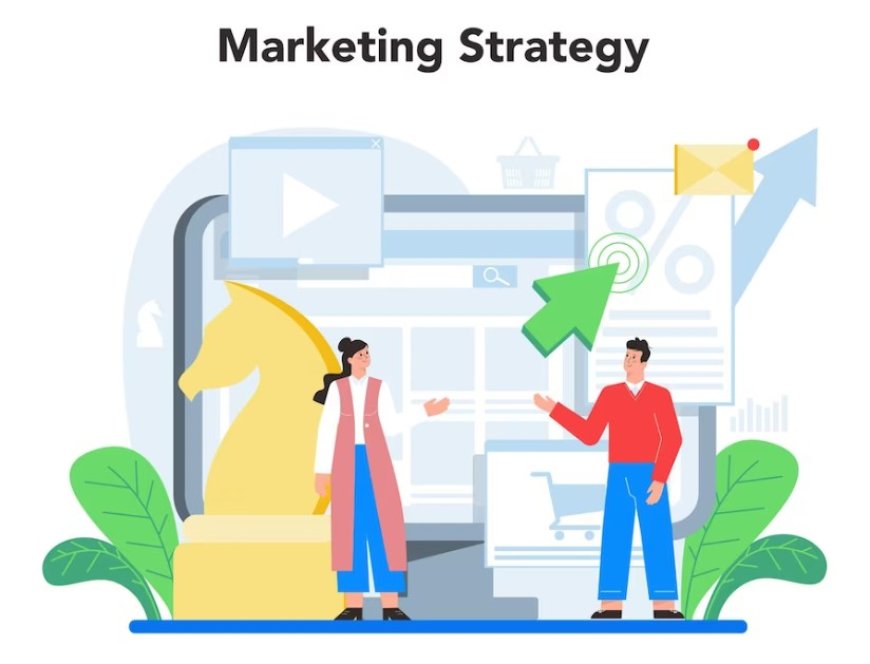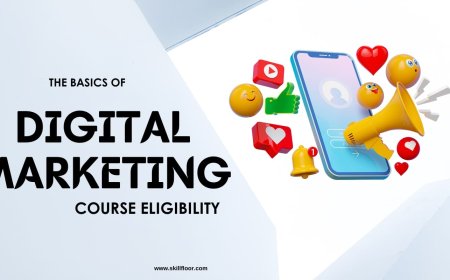How to Prepare Your Digital Marketing Strategy
Discover effective strategies for preparing your digital marketing plan. Learn key steps, tips, and techniques to enhance your online presence and business.

In today's fast-paced digital landscape, having a well-structured digital marketing strategy is crucial for any business seeking online success. From reaching your target audience to building brand awareness, a robust digital marketing plan can make all the difference. In this guide, we'll explore the essential steps, insights, and techniques to help you prepare a digital marketing strategy that not only aligns with your business goals but also ensures you stay competitive in the ever-evolving world of online marketing.
Define Your Goals and Objectives
Define Your Goals and Objectives" is a critical step in any digital marketing strategy. It essentially lays the foundation for your entire campaign and provides a clear roadmap for what you aim to achieve. In this phase, you set specific, measurable, achievable, relevant, and time-bound (SMART) goals that align with your overall business objectives. Here's a deeper explanation of why defining your goals and objectives is essential:
Clarity and Focus: Clearly articulated goals give your marketing team a sense of purpose. It helps everyone understand what they are working towards and keeps them focused on the most important tasks. Without well-defined objectives, your efforts can become scattered and less effective.
Measuring Success: Goals provide a benchmark for success. When you have quantifiable objectives, you can measure your progress and determine whether your marketing strategies are working. This measurement is essential for making data-driven decisions and optimizing your campaigns.
Resource Allocation: Defining goals also helps you allocate resources wisely. It enables you to allocate budget, time, and manpower to the areas that matter most for achieving your objectives. This prevents wastage and ensures that your resources are used efficiently.
Adaptation and Optimization: Clear goals allow you to adapt and optimize your strategies as needed. If you notice that you're not making progress toward your objectives, you can make informed adjustments to your campaigns. Without predefined goals, it's challenging to know what adjustments are necessary.
Alignment with Business Objectives: Your digital marketing efforts should always align with your broader business goals. By defining objectives that contribute directly to the growth and success of your organization, you ensure that your marketing efforts have a meaningful impact on the bottom line.
Know Your Target Audience
Know Your Target Audience" is a fundamental concept in marketing and is crucial for the success of any marketing campaign, whether it's traditional or digital. Essentially, it involves understanding the characteristics, behaviors, preferences, and needs of the group of people or individuals you are trying to reach with your products, services, or messages. Here's a brief explanation of why knowing your target audience is so important:
Identifying the right target audience allows you to tailor your marketing efforts effectively. Instead of adopting a one-size-fits-all approach, you can customize your messages, content, and strategies to resonate with the specific interests and concerns of your audience. This personalization enhances the relevance of your marketing, increasing the chances of capturing your audience's attention and engaging them.
Furthermore, knowing your target audience aids in resource allocation. It helps you make informed decisions about where to invest your marketing budget and efforts. By understanding your audience's preferred communication channels, online habits, and content consumption patterns, you can optimize your marketing mix to reach them in the most cost-effective and impactful ways.
Competitor Analysis
Competitor analysis is a critical component of any successful business strategy, especially in the realm of digital marketing. It involves a systematic examination and evaluation of the strengths and weaknesses of your competitors in the market. This process provides invaluable insights into your competitive landscape and helps you make informed decisions to stay ahead of the game.
By conducting competitor analysis, you can identify who your direct and indirect competitors are, understand their market positioning, and discern their key strategies. This information enables you to benchmark your own performance against theirs and uncover opportunities for improvement. Additionally, competitor analysis helps you identify gaps in the market that your business can exploit, whether it's by offering better products, services, or marketing campaigns.
Moreover, a thorough competitor analysis can shed light on emerging trends and changing consumer preferences. This awareness allows you to adapt your digital marketing strategies and remain relevant in a constantly evolving digital landscape. Ultimately, competitor analysis empowers you to make data-driven decisions, refine your marketing tactics, and maintain a competitive edge in your industry, fostering growth and sustainability for your business.
Choose the Right Digital Channels
In today's digital age, where consumers are constantly bombarded with information and advertisements, selecting the right digital channels for your marketing strategy is crucial to achieving success. The digital landscape offers a plethora of options, including social media platforms, search engines, email marketing, content marketing, influencer collaborations, and more. To make informed decisions, you must consider your target audience, campaign objectives, and available resources.
First and foremost, understanding your target audience is paramount. Different demographic groups and consumer personas prefer varying digital channels. For instance, if you're targeting a younger audience, platforms like Instagram and TikTok might be more effective, while LinkedIn may be more suitable for a B2B audience. Conducting thorough market research and audience segmentation helps identify where your potential customers spend their time online.
Next, your campaign objectives play a significant role in channel selection. Are you aiming to increase brand awareness, drive website traffic, generate leads, or boost sales? Each objective may require a different set of digital channels. For brand awareness, social media platforms with a strong visual focus can be valuable, while email marketing might be better for lead generation.
Content Strategy
Content strategy is a crucial component of modern marketing and digital presence management. It refers to the comprehensive plan and approach that an organization or individual adopts to create, distribute, and manage content across various digital platforms. This content can encompass a wide range of formats, including articles, videos, infographics, social media posts, and more. A well-crafted content strategy aims to achieve specific business goals, enhance brand visibility, engage the target audience, and ultimately drive desired actions, such as conversions or sales.
At its core, content strategy involves several key elements:
Audience Understanding: Understanding the target audience is paramount. Content strategists need to research and define their audience's demographics, preferences, pain points, and behaviors to create content that resonates.
Content Planning: This involves deciding what types of content to create, when to publish it, and where to distribute it. It also includes setting content objectives and KPIs (Key Performance Indicators) to measure success.
Content Creation: High-quality, valuable content is the foundation of any content strategy. Content creators must produce relevant, engaging, and informative materials that address the needs and interests of the audience.
Distribution Channels: Determining the most appropriate platforms and channels to distribute content is crucial. This can include a website, social media, email marketing, guest posting, and more. Each channel requires a tailored approach.
SEO and Keyword Research
Search Engine Optimization, commonly known as SEO, is a digital marketing strategy aimed at improving a website's visibility in search engine results. The primary goal of SEO is to increase organic (non-paid) traffic to a website by optimizing various aspects of the site to align with search engine algorithms.
SEO involves a range of techniques, both on-page and off-page, to enhance a website's ranking in search engine results pages (SERPs). On-page SEO includes optimizing content, meta tags, headings, and improving site structure for better user experience and search engine crawlers. Off-page SEO focuses on building high-quality backlinks, social signals, and online reputation to boost a site's authority and trustworthiness.
Continuous monitoring, analysis, and adaptation are crucial in SEO, as search engines frequently update their algorithms. Effective SEO practices help websites rank higher for relevant keywords, attract more organic traffic, and ultimately, achieve their online goals.
Keyword Research:
Keyword research is a fundamental component of SEO and content marketing. It involves identifying and analyzing the words and phrases (keywords) that people use when searching for information, products, or services online. The goal of keyword research is to uncover the most relevant and valuable keywords for a specific website or content piece.
Keyword research helps website owners and content creators understand their target audience's intent, preferences, and pain points. This understanding enables them to create content that resonates with users and ranks well in search engines. Keyword research tools, such as Google Keyword Planner and SEMrush, assist in finding keywords with high search volume and low competition.
Paid Advertising
Paid advertising, often referred to as pay-per-click (PPC) advertising, is a cornerstone of digital marketing strategies. It involves advertisers paying a fee each time one of their ads is clicked or, in some cases, when the ad is displayed to a user. This form of online advertising is prevalent across various digital platforms, including search engines, social media networks, and websites.
One of the key benefits of paid advertising is its ability to provide immediate visibility and generate traffic to a website or landing page. Advertisers bid on specific keywords or audience segments, and when a user's search query or online behavior matches those criteria, the ad is displayed. This targeted approach ensures that the ads are presented to users who are more likely to be interested in the product or service being offered, increasing the chances of conversion.
Paid advertising platforms offer a range of ad formats, including text ads, display ads, video ads, and more, allowing advertisers to choose the format that best suits their goals and target audience. Additionally, these platforms provide valuable data and analytics, enabling advertisers to track the performance of their campaigns in real-time and make data-driven optimizations to improve ROI.
Preparing a digital marketing strategy is an ongoing process that requires continuous learning and adaptation. By defining your goals, understanding your audience, and using the right digital channels, you can create a strategy that helps your business thrive in the digital landscape. Remember that digital marketing is dynamic, so be prepared to iterate and refine your strategy as trends and technologies evolve. With dedication and a data-driven approach, your digital marketing strategy can lead to long-term success for your brand.



























































